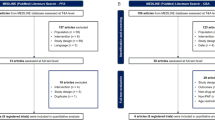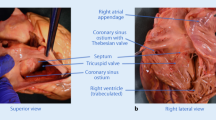Abstract
Background Patent foramina ovale (PFO) are small defects within the atrial septum that may play a role in paradoxical embolism, stroke and migraines. The relationship between PFO and atrial fibrillation (AF) has not been formally studied. We prospectively studied patients with a history of AF, versus those without (controls), in order to compare PFO prevalence among them. Methods Sixty-one patients with AF and forty-one controls completed the study, all undergoing transthoracic echocardiography using agitated saline microbubbles and a Valsalva maneuver. Results In the control group, 12/41 participants (29.2%) had PFOs compared to 5/61 (8.2%) in the AF group (P < 0.01). PFO positive patients within the entire study population demonstrated greater leftward inter-atrial septal shifting (82% vs 49%, P < 0.05). There was also reduced leftward inter-atrial septal shift observed within the AF group compared to controls (32/61 (52%) vs 31/41 (76%), P < 0.05). Conclusion This study is the first to demonstrate an apparent lower rate of PFO in patients with AF, using bubble contrast echocardiography.

Similar content being viewed by others
References
Hagen PT, Scholz DG, Edwards WD (1984) Incidence and size of patent foramen ovale during the first ten decades of life: an autopsy study of 965 normal hearts. Mayo Clin Proc 59(1):17–20
Thompson T, Evans W (1930) Paradoxical embolism. Q J Med 23:135–152
Webster MW, Chancellor AM, Smith HJ, Swift DL, Sharpe DN, Bass NM et al (1988) Patent foramen ovale in young stroke patients. Lancet 2(8601):11–12
Jones HR Jr, Caplan LR, Come PC, Swinton NW Jr, Breslin DJ (1983) Cerebral emboli of paradoxical origin. Ann Neurol 13(3):314–319
Lechat P, Mas JL, Lascault G, Loron P, Thearo M, Klimczac M et al (1988) Prevalence of patent foramen ovale in patients with stroke. NEJM 318(18):1148–1152
Hausmann D, Mugge A, Becht I, Daniel WG (1992) Diagnosis of patent foramen ovale by transesophageal echocardiography and association with cerebral and peripheral embolic events. Am J Cardiol 70(6):668–672
Sastry S, Riding G, Morris J, Taberner D, Cherry N, Heagerty A et al (2006) Young adult myocardial infarction and Ischiemic stroke: the role of paradoxical embolism and thrombophilia (The YAMIS Study). J Am Coll Cardiol 48(4):686–691
Scherzmann M, Nedeltchev K, Lagger F, Mattle HP, Windecker S, Meier B et al (2005) Prevalence and size of directly detected patent foramen ovale in migraine with aura. Neurology 65(9):1415–1418
Ferrarini G, Malferrari G, Zucco R, Gaddi O, Norina M, Pini LA (2005) High prevalence of patent foramen ovale in migraine with aura. J Headache Pain 6(2):71–76
Anzola GP, Frisoni GB, Morandi E, Casilli F, Onorato E (2006) Shunt-associated migraine responds favorably to atrial septal repair. Stroke 37:430–434
Moon RE, Camporesi EM, Kisslo JA (1989) Patent foramen ovale and decompression sickness in divers. Lancet 1(8637):513–514
Kerut EK, Truax WD, Borreson TE, Van Meter KW, Given MB, Giles TD (1997) Detection of right to left shunts in decompression sickness in divers. Am J Cardiol 79(3):377–378
Cartoni D, De Castro S, Valente G, Costanzo C, Pellicia A, Beni S et al (2004) Identification of professional scuba divers with patent foramen ovale at risk for decompression illness. Am J Cardiol 94(2):270–273
Djaiani G, Phillips-Bute B, Podgoreanu M, Messier RH, Mathen JP, Clements F et al (2004) The association of patent foramen ovale and atrial fibrillation after coronary artery bypass surgery. Anesth Analg 98(3):585–589
Berthet K, Lavergne T, Cohen A, Guize L, Bousser MG et al (2000) Significant association of atrial vulnerability with atrial septal abnormalities in young patients with ischemic stroke of unknown cause. Stroke 31(2):398–403
Ommen SR, Nishimura RA, Appleton CP, Miller FA, Oh JK, Redfield MM, Tajik AJ (2000) Clinical utility of Doppler echocardiography and tissue Doppler imaging in the estimation of left ventricular filling pressures: A comparative simultaneous Doppler-catheterization study. Circulation 102(15):1788–1794
Attaran RR, Ata I, Kudithipudi V, Foster L, Sorrell VL (2006) Protocol for optimal detection and exclusion of a patent foramen ovale using transthoracic echocardiography with agitated saline microbubbles. Echocardiography 23(7):616–622
Thanigaraj S, Valika A, Zajarias A, Lasala JM, Perez JE (2005) Comparison of transthoracic versus transesophageal echocardiography for detection of right-to-left atrial shunting using agitated saline contrast. Am J Cardiol 96(7):1007–1010
Trevelyan J, Steeds RP (2006) Comparison of transthoracic echocardiography with harmonic imaging with transoesophageal echocardiography for the diagnosis of patent foramen ovale. Postgrad Med J 82(971):613–614
Souteyrand G, Motreff P, Lusson JR, Rodriguez R, Geoffroy E, Dauphin C et al (2006) Comparison of transthoracic echocardiography using second harmonic imaging, transcranial Doppler and transesophageal echocardiography for the detection of patent foramen ovale in stroke patients. Eur J Echocardiogr 7(2):147–154
Clarke NR, Timperley J, Kelion AD, Banning AP (2004) Transthoracic echocardiography using second harmonic imaging with Valsalva maneuver for the detection of right to left shunts. Eur J Echocardiogr 5(3):176–181
Van Camp G, Franken P, Melis P, Cosyns B, Schoors D, Vanoverschelde JL (2000) Comparison of transthoracic echocardiography with second harmonic imaging with transesophageal echocardiography in the detection of right to left shunts. Am J Cardiol 86(11):1284–1287, A9
Kuhl HP, Hoffmann R, Merx MW, Franke A, Klotzsch C, Lepper W et al (1999) Transthoracic echocardiography using second harmonic imaging: diagnostic alternative to transesophageal echocardiography for the detection of atrial right to left shunt in patients with cerebral embolic events. J Am Coll Cardiol 34(6):1823–1830
Benjamin EJ, Levy D, Vaziri SM, D’Agostino RB, Belanger AJ, Wolf PA (1994) Independent risk factors for atrial fibrillation in a population-based cohort. The Framingham heart study. JAMA 271(11):840–844
Siostrzonek P, Lang W, Zangeneh M, Gossinger H, Stumpflen A, Rosenmayr G et al (1992) Significance of left-sided heart disease for the detection of patent foramen ovale by transesophageal contrast echocardiography. J Am Coll Cardiol 19(6):1192–1196
Mitchell J, Shapiro W (1969) Atrial function and the hemodynamic consequences of atrial fibrillation in man. Am J Cardiol 23(4):556–567
Clark D, Plumb V, Epstein A, Kay G (1997) Hemodynamic consequences of an irregular sequence of ventricular cycle lengths during atrial fibrillation. J Am Coll Cardiol 30(4):1039–1045
Mosvowitz C, Podolsky LA, Meyerowitz CB, Jacobs LE, Kotler MN (1992) Patent foramen ovale: a nonfunctional embryological remnant or a potential cause of significant pathology? J Am Soc Echo 5(3):259–270
Di Tullio M, Sacco RL, Venketasubramaniam N, Sherman D, Mohr JP, Homma S (1993) Comparison of diagnostic techniques for the detection of a patent foramen ovale in stroke patients. Stroke 24(7):1020–1024
Kerr AJ, Buck T, Chia K, Chow CM, Fox E, Levine RA et al (2000) Transmitral Doppler: a new transthoracic contrast method for patent foramen ovale detection and quantification. J Am Coll Cardiol 36(6):1959–1966
Agmon Y, Khandheria BK, Meissner I, Gentile F, Sicks JD, O’Fallow WM et al (2001) Comparison of frequency of patent foramen ovale by transesophageal echocardiography in patients with cerebral ischemic events versus in subjects in the general population. Am J Cardiol 88(3):330–332
Sohn DW, Song JM, Zo JH, Chai IH, Kim HS, Chung HG et al (1999) Mitral annulus velocity in the evaluation of left ventricular diastolic function in atrial fibrillation. J Am Soc Echocardiogr 12(11):927–931
Oyama R, Murata K, Tanaka N, Takaki A, Ueda K, Liu J et al (2004) Is the ratio of transmitral peak E-wave velocity to color flow propagation velocity useful for evaluating the severity of heart failure in atrial fibrillation? Circ J 68(12):1132–1138
Nagueh S, Kopelen H, Quinones M (1996) Assessment of left ventricular pressures by Doppler in the presence of atrial fibrillation. Circulation 94(9):2138–2145
Watanabe T, Iwai-Takano M, Oikawa M, Yamaki T, Yaoita H, Maruyama Y (2008) Optimal noninvasive assessment of diastolic heart failure in patients with atrial fibrillation: comparison of tissue Doppler echocardiography, left atrium size, and brain natriuretic peptide. J Am Soc Echocardiogr 21(6):689–696
Okura H, Takada Y, Kubo T, Iwata K, Mizoguchi S, Taguchi H et al (2006) Tissue Doppler-derived index of left ventricular filling pressure, E/E′, predicts survival of patients with non-valvular atrial fibrillation. Heart 92(9):1248–1252
Lee S, Jung J, Choi S, Lee N, Park W, Oh D et al (2006) Determinants of brain natriuretic peptide levels in patients with lone atrial fibrillation. Circ J 70(1):100–104
Author information
Authors and Affiliations
Corresponding author
Rights and permissions
About this article
Cite this article
Attaran, R.R., Baweja, G., Foster, L. et al. Lower patent foramen ovale detection with transthoracic echocardiography in atrial fibrillation. Int J Cardiovasc Imaging 24, 819–824 (2008). https://doi.org/10.1007/s10554-008-9334-0
Received:
Accepted:
Published:
Issue Date:
DOI: https://doi.org/10.1007/s10554-008-9334-0




